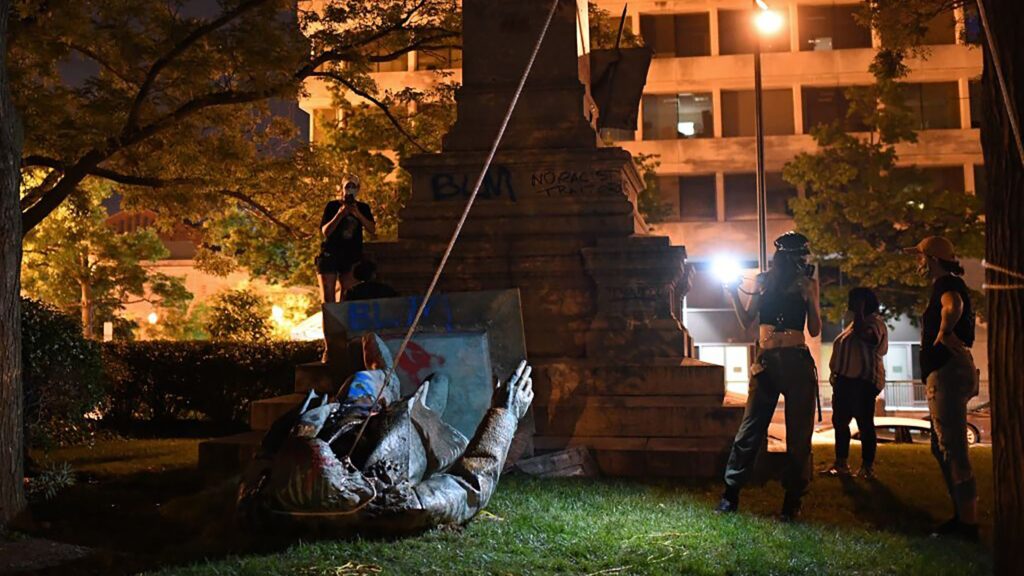The NPS says that refurbishing and reinstalling the toppled statue “aligns with federal responsibilities under historic preservation law”
(Photo: ERIC BARADAT/AFP via Getty Images)
Published August 6, 2025 03:30PM
The National Park Service will restore and install the bronze statue of a Confederate general in Washington D.C. five years after it was torn down during the 2020 Black Lives Matter protests.
According to a news release from the agency, reinstalling the statue of Albert Pike, a brigadier general in the Confederate Army during the U.S. Civil War, “aligns with federal responsibilities under historic preservation law, as well as recent executive orders to beautify the nation’s capital and re-instate pre-existing statues.”
The NPS statement, issued on Monday, August 4, says that the statue, which was originally installed in 1901, a decade after Pike’s death, is intended to honor his leadership in the order of Freemasons, an exclusive and secretive fraternity. The statue honors his “32 years as Sovereign Grand Commander of the Ancient Rite of Scottish Freemasonry,” the release reads.
The news release does not mention Pike’s military service with the Confederate States of America during the U.S. Civil War.
Prior to its destruction in 2020, Pike’s statue was the only statue of a Confederate officer in the U.S. capitol, outside of museums. However, the statue, which was erected by Freemasons, did not explicitly mention Pike’s military service, and he was not depicted in uniform. An inscription on the plinth read: Author, Poet, Scholar, Soldier, Jurist Orator, Philanthropist, Philosopher.
According to The New York Times, Pike served as a diplomat to Native American tribes that the Confederacy hoped to enlist to fight the Union, and only commanded his troops in a single engagement, the Battle of Pea Ridge, which saw his unit routed. Pike was later charged by his commanding officers with insubordination and treason, and escaped punishment by resigning his command.
In the years following the war, Pike also had ties to the Klu Klux Klan, however critics have disputed that he was a member of the racist organization. A biography entitled, A Life of Albert Pike (1997), says Pike once declared that “the white race, and that race alone, shall govern this country.”
Though it stood for over a hundred years in Washington D.C.’s Judiciary Square neighborhood, just a few blocks from the National Mall, Albert Pike’s statue sparked controversy. Union Army veterans petitioned the government to block the statue’s installment when it was first approved in 1898. The D.C. Council first began petitioning the federal government to remove the statue in 1992, and renewed said petition as recently as 2017.
Congressional delegate Eleanor Holmes Norton, who represents the District of Columbia in the House of Representatives, introduced a bill to remove the statue in 2019, but it was destroyed before the bill passed. (Norton’s legislation was later passed by the House Committee on Natural Resources.)
In a press release on August 4, Norton decried the decision to restore and reinstall the statue, calling it, “as odd and indefensible as it is morally objectionable.” She said she planned to reintroduce her bill to have the statue removed permanently.
“Pike served dishonorably,” Norton said. “He took up arms against the United States, misappropriated funds, and was ultimately captured and imprisoned by his own troops. He resigned in disgrace after committing a war crime and dishonoring even his own Confederate military service. Even those who want Confederate statues to remain standing would have to justify awarding Pike any honor, considering his history.” (Her reference to a “war crime” refers to the actions of Cherokee under Pike’s command at the Battle of Pea Ridge. There were reports of the Cherkoee scalping federal dead.)
In its announcement of the statue’s restoration, the NPS specifically cited two of President Trump’s executive orders: “Making the District of Columbia Safe and Beautiful” and “Restoring Truth and Sanity to American History.” The latter executive order has been used as justification for other major changes in national parks across the country, including signs asking visitors to report negative information about past or living Americans.
The agency plans to have Albert Pike’s statue fully restored and installed in October.


